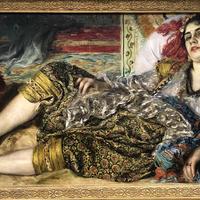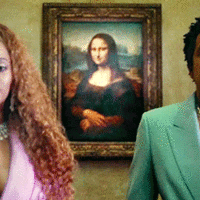More about Oath of the Horatii
- All
- Info
- Shop

Contributor
Oath of the Horatii depicts three heroic brothers, off to save the day by murdering various family members. It’s an honor thing.
David depicts a handful of heroes ready for battle. Three brothers from the Roman Horatii family are off to fight a trio of Curiatii brothers from their rival city, Alba Longa. Their sacrifice will end the war, determining which city will call the shots. The father of the Horatii here gives them their swords, apparently thrilled that his children will die for Rome. To the side are the Horatii’s sisters, one of whom has a Curiatii fiancé. Another is a Curiatii herself, married into the Horatii family. This whole fight to the death shebang is beginning to look like a bad idea.
Horatius, a Horatii brother, would win the fight as the sole survivor. Being a champion didn’t keep him from being a massive prick, and he brought back trophies from the dead. One of these mementos? A cloak his sister Camilla had made for her fiancé by hand. Camilla’s distress assured Horatius that she was not the brainwashed devotee of Rome she should have been. He had just the remedy— a sword in the chest.
David’s masterpiece would later be used as a symbol of the French Revolution due to its message of patriotic duty and loyalty to the cause over personal attachment. Shouldn’t the message of this story be to restrain your patriotism when it turns you into a raging murderer? Let’s not all follow the example of the jackass who stabbed his sister for mourning her fiancé.
This painting marks the start of our hero’s turn from Rococo. Remember when Renoir was criticized for being ahead of his time and van Gogh’s fame took the long way around? David’s shift from the style of Boucher and Fragonard was, to the contrary, welcomed with a standing ovation. Ever like something just because everyone else does? This is the only excuse for the wild popularity of Rococo in Europe, and it took just one neoclassical trend-setter to break the spell. Europeans must have been thoroughly sick of cherubs and spring blossoms, because the Salon of 1785 was forced to expand its business hours to account for the hordes of visitors. Extra work for the janitors and gallery staff, to be sure, but certainly worth it to turn the art world from Rococo once and for all.
Sources
- “David, Oath of the Horatii.” Khan Academy. Accessed June 27, 2017. https://www.khanacademy.org/humanities/ap-art-history/later-europe-and-….
- “Horatii and Curiatii.” Encyclopedia Britannica. July 20, 2007. Accessed June 27, 2017. https://www.britannica.com/topic/Horatii-and-Curiatii#ref934825.
- “Jacques-Louis David: The Oath of the Horatii.” Neo-Classicism and French Revolution. Accessed June 27, 2017. http://www.bc.edu/bc_org/avp/cas/his/CoreArt/art/neocl_dav_oath.html.
- “Oath of the Horatii.” Wikipedia. June 22, 2017. Accessed June 27, 2017. https://en.wikipedia.org/wiki/Oath_of_the_Horatii.
Featured Content
Here is what Wikipedia says about Oath of the Horatii
Oath of the Horatii (French: Le Serment des Horaces) is a large painting by the French artist Jacques-Louis David painted in 1784 and 1785 and now on display in the Louvre in Paris. The painting immediately became a huge success with critics and the public and remains one of the best-known paintings in the Neoclassical style.
It depicts a scene from a Roman legend about a seventh-century BC dispute between two warring cities, Rome and Alba Longa, and stresses the importance of patriotism and masculine self-sacrifice for one's country. Instead of the two cities sending their armies to war, they agree to choose three men from each city; the victor in that fight will be the victorious city. From Rome, three brothers from a Roman family, the Horatii, agree to end the war by fighting three brothers from a family of Alba Longa, the Curiatii. The three brothers, all of whom appear willing to sacrifice their lives for the good of Rome, are shown stretching their hands towards their father who holds their swords out of them. Of the three Horatii brothers, only one will survive the confrontation. However, it is the surviving brother who is able to kill the other three fighters from Alba Longa: he allows the three fighters to chase him, causing them to separate from each other, and then, in turn, kills each Curiatii brother. Aside from the three brothers depicted, David also represents, in the bottom right corner, a woman crying while sitting down. She is Camilla, a sister of the Horatii brothers, who is also betrothed to one of the Curiatii fighters, and thus she weeps in the realisation that, whatever happens, she will lose someone she loves. Seeing her weep, the surviving brother, Publius, kills Camilla for weeping over the enemy.
The principal sources for the story behind David's Oath are the first book of Livy (sections 24–26) which was elaborated by Dionysius in book 3 of his Roman Antiquities. However, the moment depicted in David's painting is his own invention.
It grew to be considered a paragon of neoclassical art. The painting increased David's fame, allowing him to take on his own students.
Check out the full Wikipedia article about Oath of the Horatii

















